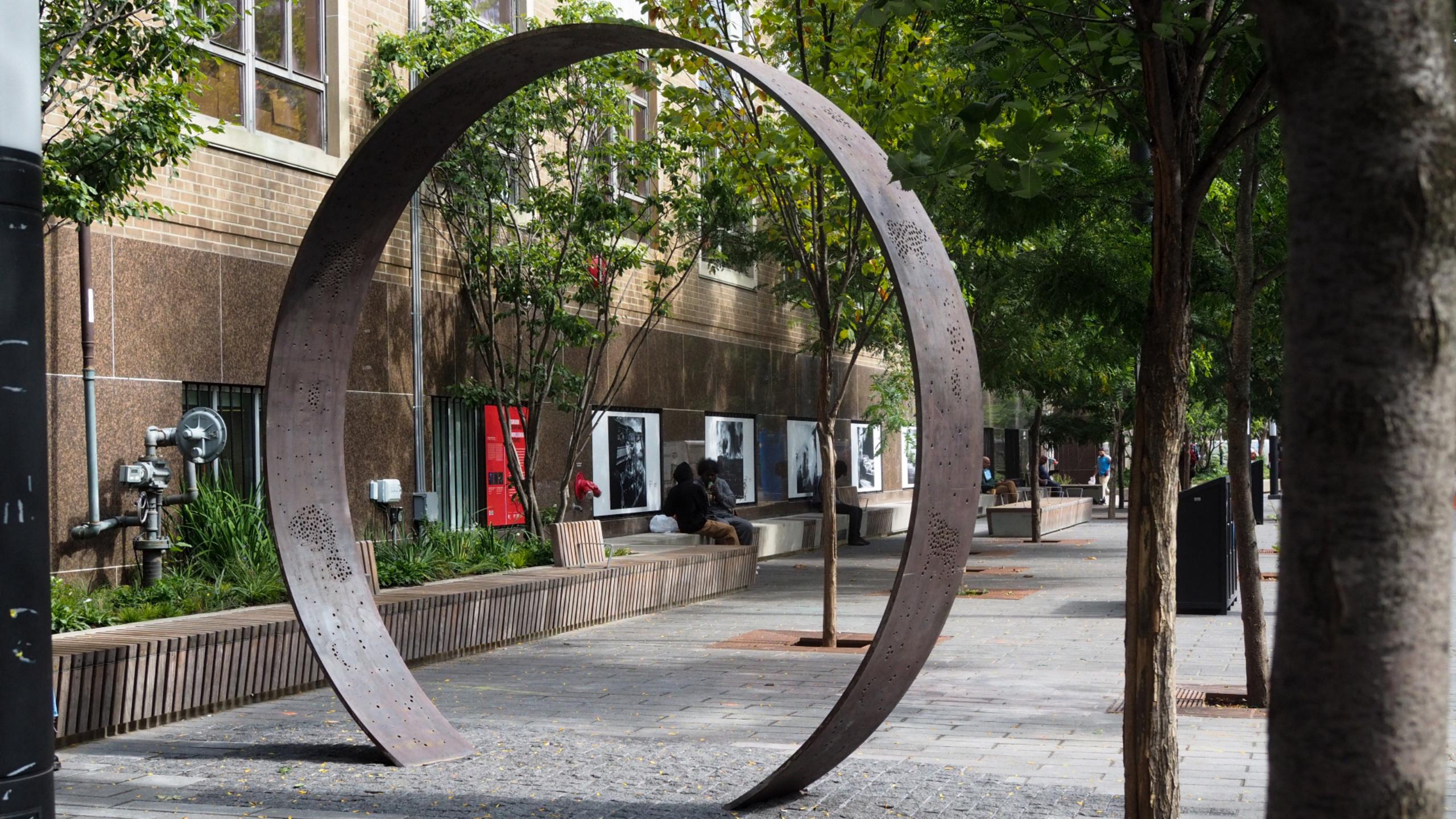By Prapti Bamaniya
A new steel Ring art installation, designed by Indigenous architecture firm Two Row Architect, was unveiled at the intersection of Gould Street and the Nelson Mandela Walk on Sept. 21.
According to architects Jacqueline Daniel and Matthew Hickey, the art installation was an ongoing project with the university for two years. They said the project involved consultations with Joanne Okimawininew Dallaire, elder and co-chair of Ryerson’s Truth and Reconciliation Strategic Working Group; Brian Norton, the program coordinator at Aboriginal Student Services; and Monica McKay, the director of Aboriginal Initiatives. The consultation started with six sharing circles with Indigenous communities and collected ideas were brought up.
According to a study in The International Journal of Qualitative Methods, Indigenous Peoples have used sharing circles as a method of conveying stories and experiences for generations and they provide a respectful and supportive environment where “Indigenous Peoples can autonomously express their perspectives and reflect on their experiences without interruption or questioning.”
“It’s really about the Indigenous community having a voice at the university. We were just the facilitators,” said Hickey.
Next came exercises like “design charrettes,” where the groups would use materials like pipe cleaners and plasticine to mould what they thought the installation could look like. After coming up with some concepts through that process, the architects came up with three different schematics for the installation and presented them to the community to choose the best design. After showing the focus group of elders and Indigenous leaders at Ryerson, the current “Ring” installation was chosen.
“We really are the bridge between the client or the people that we’re working with and the community that it’s for,” said Daniel. “It’s less about my personal design tastes and more about the translation of what people see and feel and want for their buildings or installations.”
“It’s really about the Indigenous community having a voice at the university”
According to Ryerson’s official statement, the Ring is made of Corten weathering steel, a material that is less processed and more likely to change with its environmental conditions, so that its exterior changes with the weather. It incorporates the Seven Grandparent teachings and their animal symbols: Humility, Courage, Honesty, Wisdom, Truth, Respect and Love.
Hickey said it also includes a depiction of the lunar moon phases with it being surrounded by stars and the constellation Pleiades, an integral constellation for some Indigenous communities.
The installation’s opening faces east, representing creations and new beginnings, and west, representing knowledge and wisdom.
“Passed down from generation to generation, First Nations communities have long referred to the Seven Grandparent teachings as a guide for their cultural foundation, human conduct and survival,” said Dallaire in a statement.
“In our traditional Indigenous teachings, everything is about intent and the right relationship with our world, so as we continue to navigate the many challenges of the past year, I’m grateful that we were able to come together as a community to bring this meaningful vision to life.”
Lynn Lavallée, a strategic lead in Indigenous resurgence in the Faculty of Community Services, who is Anishinaabe registered with the Métis Nation of Ontario, said she knows this installation is important as it gives Indigenous people a chance to see a representation of themselves on campus.
“For me, Indigenous resurgence is about supporting Indigenous people within the academy and for this reason, I feel that artwork can serve a purpose to make the Indigenous people on campus feel welcome and recognized,” she said.
On the other hand, Wreckonciliation X University, a group of Indigenous students fighting for social justice and human rights at the university, expressed frustration on Instagram over the installation being unveiled before a new name for the institution.
“Where was the consultation? Why did this happen before the name change? What are the priorities here?” their Instagram post reads.
Ryerson history professor and former co-chair of the Standing Strong Task Force, Catherine Ellis, said she understands the time, work and thought that went into the new art installation.
She said its process included important dialogue about the role of public art in a social environment.
“As our campus engages in necessary conversation about how to implement the recommendations of the Task Force, this piece can provide our community with opportunities for reflection, grounding and imagining what the future can look like,” she said.











Leave a Reply